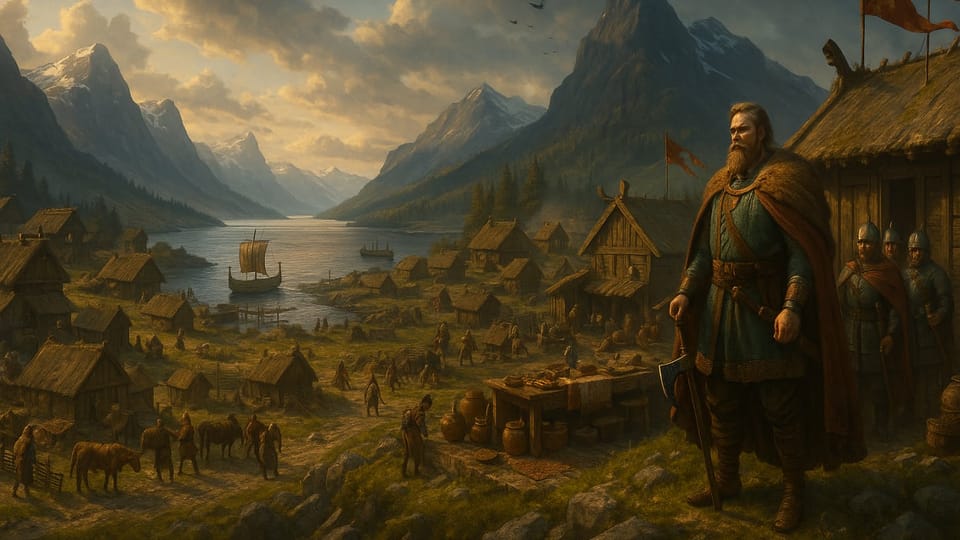Jarls, Karls, and Thralls

The Vikings, those badasses from what we now call Denmark, Norway, and Sweden, didn’t just sail around for kicks. They left a mark on European history that’s still echoing today. But to really get these guys, you’ve got to dig into their social setup, which was all about three main classes: Jarls, Karls, and Thralls. This trio didn’t just sort out who did what — it shaped every bit of Viking life, from culture to economy.
Jarls: The Noble Class
First up, we’ve got the Jarls. These guys were the top dogs, the nobles. They were rich and powerful and held massive estates. Their clout came from their bloodline and their knack for leading and fighting.
Jarls were the big shots, running the show socially and politically. They kept the peace, judged disputes, and led warriors called housecarls. When it came to Viking raids or trade missions, Jarls were the masterminds.
Their cash flow came from land, trade, and raiding spoils. They lived large in fortified longhouses with their families and retainers. Think luxury: fine clothes, imported goods, and epic feasts. They were also patrons of the arts, backing poets and craftsmen to hype up their deeds and legacy.
Jarls were major players in the Things, those Viking assemblies where laws and policies got hashed out. Sometimes, a Jarl could challenge a king or snag the throne, showing how fluid Viking power could be.
Karls: The Free Commoners
Next, we have the Karls, the free commoners — the backbone of Viking society. These were your farmers, craftsmen, merchants, and warriors, enjoying rights and freedoms that set them apart from the Thralls.
Karls kept the Viking world spinning, farming the land, crafting goods, and trading near and far. Most were farmers, working their own plots and raising livestock. Craftsmen made essential tools and items, while merchants kept the trade routes buzzing.
Karls lived in simple wooden homes within tight-knit communities. Family was everything, with extended clans living and working together. They held feasts and community projects to strengthen their bonds.
When it came to fighting, Karls were front and center. Every free man had to defend his home and could be called for raids or defense. Victorious warriors could score serious prestige and wealth.
Karls had legal protections and could speak at the Things, giving them a say in local governance. Their status as free men meant they could own property, marry freely, and seek justice, marking a clear line between them and the Thralls.
Thralls: The Enslaved Class
Finally, we have the Thralls, the enslaved class. Thralls were captured in raids, born into slavery, or folks who fell into debt. They were property with few rights.
Thralls did the grunt work — farming, tending livestock, and household chores. Skilled Thralls might craft or perform specialized labor, but their main gig was serving their owners.
Life as a Thrall was rough. They lived in cramped quarters near their masters, ate basic food, and wore simple clothes. Despite the harshness, Thralls were crucial to the Viking economy, doing the heavy lifting that kept everything running.
Path to Freedom: Some Thralls could earn freedom through service, wealth, or their master’s goodwill. Freed Thralls, or leysingr, often stayed on as tenants or workers, gaining more rights and autonomy.
Thralls had minimal legal protections and were under their masters’ control. They could be traded or sold, and their treatment varied widely. Viking law offered some protection against extreme abuse, but life was still tough.
The Interplay of Classes
Now, here’s where it gets interesting. Jarls, Karls, and Thralls were all interdependent. Jarls needed Karls for economic output and military support, while both relied on Thralls for labor. Social norms, laws, and economic needs upheld this hierarchy, creating a structured yet dynamic society.
The Viking economy was mainly agrarian. Karls’ farming was vital, and their surplus drove trade, often handled by the Jarls. Thralls’ labor kept farms and estates running, freeing Karls and Jarls for other pursuits like trade and war.
Mobility was possible though the social structure was strict. Exceptional Karls could climb the ranks through trade, craftsmanship, or valor in battle, sometimes matching lower-ranking Jarls. Conversely, Jarls could fall from grace. Some Thralls could earn their freedom, adding a touch of fluidity to the hierarchy.
Honor, loyalty, and kinship were core Viking values. Things assemblies allowed free men to voice their opinions and influence governance. Legal codes favored the upper classes but aimed for justice and order, helping mediate conflicts and maintain stability.
So there you have it — the Viking social structure, with its Jarls, Karls, and Thralls. This setup shaped every aspect of their society, from day-to-day life to epic historical events. Understanding this hierarchy gives us a peek into the complexities of Viking life and the interplay of power, labor, and social norms that defined their world.
